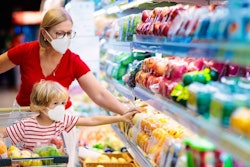
When the Coronavirus disease (COVID-19) pandemic first began in March 2020, the main goal was to keep people safe. Companies encouraged their employees to work from home, moving most of their operations online. Because of this, many thought that sustainable practices were going to fall to the wayside as people adjusted to this “New Normal,” however, the exact opposite happened. The supply chain industry put sustainable initiatives at the forefront, creating long-term solutions for an ongoing climate crisis.
Sustainability practices—including environmental, economical and ethical—allow companies the opportunity to better prepare for supply chain disruptions in the future.
Crisp has made it a mission to lead digital transformation in the food supply chain, enabling companies to use data to improve efficiency and reduce waste. In partnership with Greenleaf Foods, Crisp was able to help reduce out-of-stocks, minimize waste, track inventory and adapt to any potential disruptions.
As part of their shared commitment to sustainable practices, Crisp and Greenleaf developed a new waste tracker for food suppliers. The tracker monitors sales and on-hand inventory at distribution centers to identify and possibly prevent food safety hazards that make occur, largely avoiding food waste. Greenleaf can now identify if a particular warehouse has a large supply of a given product set to expire and move the product or cut back on the next order volume.
"With Crisp, we are now able to identify potential inventory spoilage risk with enough clarity and time to mitigate waste and penalties. This would typically be something that requires combing through multiple reports and circling back to make sure it lines up. Crisp and Greenleaf have partnered to create a single source that identifies these potential losses," says Adam Moleta, key account manager for the natural channel at Greenleaf Foods.
The Crisp Data Platform helped Greenleaf achieve end-to-end sourcing, making point-of-sale data readily accessible at the individual SKU level. This data allows for accurate forecasts and production plants. Since Greenleaf’s products are produced in-house, the company has found it easier to translate data-driven plans into actions.
“Working with Crisp, we are able to use data to manage the business more smoothly and it saves us a significant amount of time,” Moleta explains.
Still, the COVID-19 pandemic brought on a series of challenges for Greenleaf, as demand for its products increased significantly throughout the year.
Greenleaf addressed these issues by working with Crisp to re-work its facilities to in order to ensure the health and safety of its employees, while taking on new data platforms to address any supply and demand needs. By getting ahead of his supply chain partners’ needs, Greenleaf has time to replenish supply and avoid stock-outs. By being proactive instead of reactive, Greenleaf is now well-positioned to take on continuous growth in 2021. Most recently, the company announced the acquisition of a new Tempeh, Ind., production facility that will allow the company to keep up with increased growth.
Crisp has made it a mission to break down silos in the supply chain through real-time data sharing between trading partners, Are Traasdahl, founder and CEO, Crisp explains. This strategy allows for companies, like Greenleaf, to communicate dynamically and efficiently across their entire supply chain network.
The companies also created a “Potential Lost Sales” dashboard that enables the team to cross reference inventory in order to identify any gaps. This capability allows Greenleaf to work directly with buyers as well as retailers to stay ahead of inventory and ensure service levels at the customer level remain as high as possible.
“The supply chain data in Crisp pulls together insights that typically exist across three to four different reports. Keeping an eye on replenishment is especially important in the natural channel, which includes a number of independent retailers, and by tracking their inventory all in one place, he can better stay on top of the channel overall,” says Moleta.




















